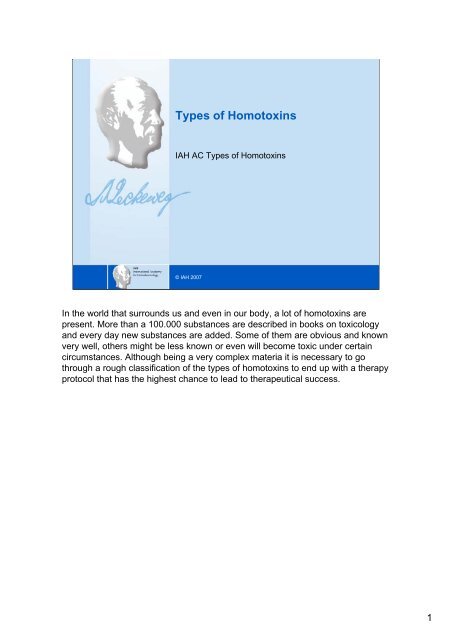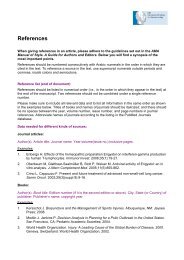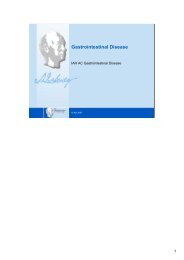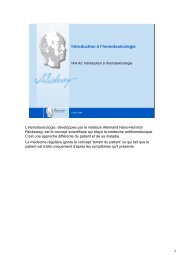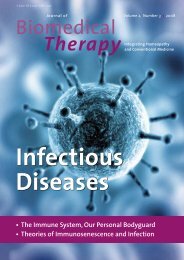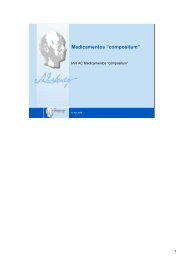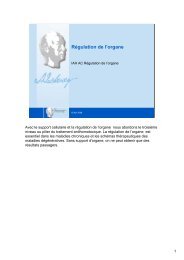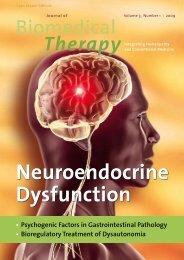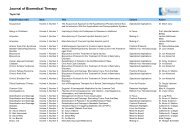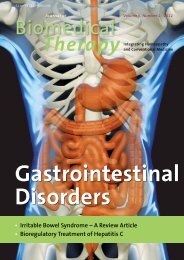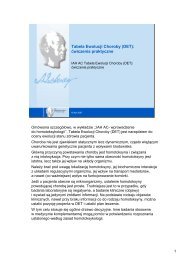Types of Homotoxins
Types of Homotoxins
Types of Homotoxins
You also want an ePaper? Increase the reach of your titles
YUMPU automatically turns print PDFs into web optimized ePapers that Google loves.
<strong>Types</strong> <strong>of</strong> <strong>Homotoxins</strong><br />
IAH AC <strong>Types</strong> <strong>of</strong> <strong>Homotoxins</strong><br />
© IAH 2007<br />
In the world that surrounds us and even in our body, a lot <strong>of</strong> homotoxins are<br />
present. More than a 100.000 substances are described in books on toxicology<br />
and every day new substances are added. Some <strong>of</strong> them are obvious and known<br />
very well, others might be less known or even will become toxic under certain<br />
circumstances. Although being a very complex materia it is necessary to go<br />
through a rough classification <strong>of</strong> the types <strong>of</strong> homotoxins to end up with a therapy<br />
protocol that has the highest chance to lead to therapeutical success.<br />
1
Objective:<br />
• Identify the different types <strong>of</strong> homotoxins present in the natural<br />
environment.<br />
• Describe the effects <strong>of</strong> homotoxins on living organisms.<br />
• Indicate the possible antihomotoxic preparations that can help<br />
neutralise them.<br />
© IAH 2007<br />
2<br />
The objectives <strong>of</strong> this lecture are to identify the different types <strong>of</strong> homotoxins<br />
present in our natural environment, to describe their toxic effects on the human<br />
organism and to indicate the possible preparations that might help to neutralise<br />
them.<br />
For a general drainage and detoxification we refer to the lecture IAH AC Drainage<br />
and Detoxification<br />
2
Agenda:<br />
• Definition <strong>of</strong> homotoxin<br />
• <strong>Types</strong> <strong>of</strong> homotoxins<br />
• Chemical toxins<br />
• Insidious toxins<br />
• Diet and toxicity<br />
• Drugs as toxins<br />
• Neural interference fields<br />
• Psychotoxins<br />
© IAH 2007<br />
3<br />
3
Definition <strong>of</strong> a homotoxin<br />
• A homotoxin is any substance that creates a direct or indirect<br />
toxic burden in the human organism.<br />
© IAH 2007<br />
4<br />
A homotoxin is defined as any substance that has a direct or indirect damaging<br />
effect on the human organism. Not the substance in itself is the most important.<br />
Crucial is its effect on the organism.<br />
4
<strong>Types</strong> <strong>of</strong> homotoxins<br />
• Exogenous homotoxins<br />
• Extern toxic burdens that comes into the body or interferes<br />
with it (e.g. arsenic, tobacco smoke, heavy metals etc.)<br />
• Endogenous homotoxins<br />
• Created in the body, mostly as consequence <strong>of</strong> metabolic<br />
processes (e.g. ammoniac, CO 2 , etc.)<br />
© IAH 2007<br />
5<br />
We divide homotoxins into two big groups: the exogenous and endogenous ones.<br />
Exogenous homotoxins are substances that come from the environment into the<br />
body and have a direct or indirect toxic effect on tissues, organs or regulation<br />
mechanisms. Even a healthy lifestyle is no guarantee for being free <strong>of</strong> exogenous<br />
homotoxins as in a lot <strong>of</strong> them we can barely influence the intake (dust in the air,<br />
radiations, gasses, etc…). Some <strong>of</strong> them are toxic in small dosages, others need<br />
a higher doses or prolonged intake <strong>of</strong> smaller quantities. Some <strong>of</strong> the exogenous<br />
homotoxins become extremely toxic in combination with other substances.<br />
Avoidance behaviour is not enough to stay clean <strong>of</strong> toxins as a huge part may<br />
come in without the person is knowing it.<br />
Endogenous homotoxins are created by the organism itself. Hereunder we find a<br />
lot <strong>of</strong> metabolic intermediary or end products. Even substances that under normal<br />
circumstances are present in the body but that are toxic if they accumulate must<br />
be seen as homotoxins and become therapeutically important when we can’t<br />
eliminate them over normal physiological processes.<br />
5
“The dose makes the poison”<br />
Paracelsus<br />
© IAH 2007<br />
6<br />
Centuries ago Paracelsus already referred to the importance <strong>of</strong> a dose to call a substance toxic.<br />
Arsenic is commonly known as a very toxic substance but few people are aware that we find<br />
arsenic in a lot <strong>of</strong> food we daily eat,… but only in very minor doses. Higher dosages are deathly,<br />
very low dosages <strong>of</strong> a toxin can even be beneficial to the organism. Other substances we declare<br />
without any doubt as healthy can become extremely toxic in high doses (to drink more clean<br />
water than 30% <strong>of</strong> our body weight within 24 hours is deathly dangerous). So there is more than<br />
just the substance itself that makes it toxic. We should look at<br />
•the substance<br />
•the (repeated) doses<br />
•the time <strong>of</strong> interaction with the organism<br />
•the adaptation to the intoxication<br />
•the susceptibility <strong>of</strong> the organism<br />
•the storage capacities (ECM)<br />
•the excretion capacities<br />
•the (potentialising or inhibiting) interactions with other substances out <strong>of</strong> the direct environment <strong>of</strong><br />
the organism<br />
•The combination <strong>of</strong> the doses and time <strong>of</strong> impact <strong>of</strong> the toxin might cause unexpected intoxication<br />
effects. A high acute doses <strong>of</strong> a toxin is almost always dangerous but so so might be a long term<br />
intoxication with a small doses.<br />
So, in fact we could say that a homotoxin only becomes toxic in the organism under well defined<br />
conditions and that not every homotoxin has the same toxicity degree <strong>of</strong> toxicity for every human<br />
organism. We can put down guidelines and standards but they are not applicable without nuances<br />
to all human beings in the same way.<br />
6
<strong>Homotoxins</strong>:<br />
• Chemical toxins<br />
• Insidious toxins<br />
• Diet and toxicity<br />
• Drugs as toxins<br />
• Neural interference fields<br />
• Psychotoxins<br />
© IAH 2007<br />
7<br />
Beside the homotoxin itself aspects <strong>of</strong> lifestyle and environment have to be<br />
studied. There are chemical aspects, nutritional aspects, modern medication or<br />
pharmacological aspects and even factors that are related to regulation rigidity<br />
and interference fields. So these are the main factors determining homotoxic<br />
overload.<br />
7
Factors determining homotoxic<br />
overload<br />
Chemical poisoning<br />
© IAH 2007<br />
In these modern times with high industrial environment, synthetic molecules,<br />
social bereavement, psychological pressure and suppression medicine, chemical<br />
poisoning will find a lot <strong>of</strong> potentizing factors to create toxicity in the human body.<br />
As mentioned before, chemical homotoxic overload is not that easy to escape<br />
from as in highly economically developed countries they became part <strong>of</strong> life due<br />
to governmental choices made in the past and consequential environmental<br />
pollution. Cosmic radiations (ozone layer damaging), radioactivity, pseudoestrogens<br />
in fish, heavy metals in the direct environment,… they all are the same<br />
for everyone, independent the lifestyle or choices made. Even moving out from a<br />
region is not always a solution as some <strong>of</strong> the toxic substances are travelling over<br />
the air to so called pure and natural regions.<br />
8
Chemical poisoning: toxicological criteria<br />
• Bioaccumulation<br />
• Tendency <strong>of</strong> a substance to accumulate in the tissues <strong>of</strong> live<br />
organisms by bioaccumulation<br />
• Related to hydrophobic and lipophylic characteristics<br />
© IAH 2007<br />
9<br />
Paracelsus stated that the doses makes the poison. In this way it looks like that<br />
only a high doses <strong>of</strong> a toxin will create an intoxication status which is not always<br />
true. Even very little amounts <strong>of</strong> chemical loads, repeated over decades, can<br />
create a bioaccumulation that becomes extremely dangerous after a long period.<br />
In the lecture ‘IAH AC Matrix histology and physiology’ we mentioned already that<br />
there are at least 3 ways in which toxins can get incorporated into the structure <strong>of</strong><br />
the extra cellular matrix. This can be due to a positive charge (the ECM structure<br />
is predominantly negative charged), by hydrophilic characteristics or due to pure<br />
mechanic aspects (size <strong>of</strong> the toxin). So, even presented in very small amounts<br />
at the time, bioaccumulation can be the cause that a toxic level is reached, even<br />
if it takes years to do so.<br />
Still now in Europe, older people are found that were active in the flora sector and<br />
have still a high accumulation <strong>of</strong> DDT in the liver, a substance that has been<br />
banned for more than 2 decades now.<br />
9
Chemical poisoning: toxicological criteria<br />
• Toxicity<br />
• Adverse effects on human and animal health<br />
• Can be divided into seven basic characteristics...<br />
© IAH 2007<br />
10<br />
The toxic effect <strong>of</strong> a chemical substance is dependent on certain criteria. Not all<br />
chemicals are toxic in the same way for living species. Some <strong>of</strong> them are<br />
extremely toxic for plants and almost not to animals or humans and vice versa.<br />
That is why a more specific and closer look at this materia is needed.<br />
10
Chemical poisoning: toxicological criteria<br />
• Toxicity<br />
• Acute lethality<br />
• Sublethal effects on non-mammalian species<br />
• Sublethal effects on plants<br />
• Sublethal effects on mammals<br />
• Teratogenicity<br />
• Genotoxicity/mutagenicity<br />
• Carcinogenicity<br />
© IAH 2007<br />
11<br />
For most chemicals the acute lethal dose is described in pr<strong>of</strong>essional literature. We have to be<br />
aware that not the single lethal dose alone is toxic but also that bioaccumulation is possible and<br />
repeated dosages are added to residual amounts <strong>of</strong> an earlier intake, a lethal dose can be<br />
reached. Think about the bioaccumulation <strong>of</strong> heavy metals like lead.<br />
Toxic effects can be seen on non mammalian species and can have an effect on long term due to<br />
the food cycle. The same is the case for poisoned plants.<br />
The sublethal effects <strong>of</strong> chemicals on mammals are quite well described but <strong>of</strong>ten forgotten in the<br />
patient’s history. Work related intoxications, domicile (industrial or not), chemically treated food,<br />
especially in the long term can cause sublethal intoxicating effects.<br />
Some chemicals can induce consequences in embyological development. In this case the toxicity<br />
in the mother causes deviations in the child. This is not only the case with pure chemicals out <strong>of</strong><br />
the environment but also chemicals or substances used in pharmacology (e.g. S<strong>of</strong>tenon children<br />
in the 60-ties)<br />
Other chemicals have a genotoxicity and are the cause <strong>of</strong> genetic dysfunctions. This has <strong>of</strong>ten not<br />
only physical but also physiological consequences.<br />
Many substances are known to be carcinogenic. They are described in pr<strong>of</strong>essional literature due<br />
to their carcinogenic properties. Also here we see both: the acute toxic doses that triggers cell<br />
dedifferentiation and accumulated dosages that after long term induce the same.<br />
11
Chemical poisoning: principal pollutants<br />
• Acidifying substances<br />
• Ammonia<br />
• Nitrogen oxides<br />
• Sulfur dioxide, etc.<br />
© IAH 2007<br />
12<br />
The PH <strong>of</strong> the cellular environment is extremely important and the slightest deviations might<br />
cause dysfunctions or even irreversible damage.<br />
Ammonia is a product <strong>of</strong> protein catabolism and is metabolized by the liver. Normal blood<br />
ammonia levels range from 80-110 mcg/dL. Theoretically, patients with liver dysfunction are at<br />
increased risk for ammonia toxicity; we even measure ammonia as a sign <strong>of</strong> liver failure.<br />
NOx is a generic term for the various nitrogen oxides produced during combustion. They are<br />
believed to aggravate asthmatic conditions, react with the oxygen in the air to produce ozone,<br />
which is also an irritant and eventually form nitric acid when dissolved in water. When dissolved in<br />
atmospheric moisture the result can be acid rain which can damage both trees and entire forest<br />
ecosystems, with the human being at the end <strong>of</strong> the chain<br />
Sulfur dioxide is sometimes used as a preservative in alcoholic drinks, or dried fruits due to its<br />
antimicrobial properties. The preservative is used to maintain the appearance <strong>of</strong> the fruit rather<br />
than prevent rotting. This can give fruit a distinctive chemical taste.<br />
Sulfur dioxide is also a good reductant. In the presence <strong>of</strong> water, sulfur dioxide is able to<br />
decolorize substances that can be reduced by it; thus making it a useful reducing bleach for<br />
papers and delicate materials such as clothes. The emissions <strong>of</strong> tons <strong>of</strong> sulphur dioxide over<br />
decades is one <strong>of</strong> the main causes <strong>of</strong> acid rain.<br />
12
Chemical poisoning: principal pollutants<br />
• Metals and metalloids...<br />
• Cadmium<br />
• Mercury<br />
• Lead<br />
© IAH 2007<br />
13<br />
Heavy metals are all around in the modern industrial environment.<br />
Cadmium is one <strong>of</strong> the few substances in nature that have absolutely no value to living beings.<br />
Due to bioaccumulation, even in very small concentrations, isolated or in combination with other<br />
substances it is extremely toxic for living organisms and eco systems. Inhaled cadmium gasses<br />
are highly toxic to the kidneys and lungs. Oral intake can damage kidneys and liver severely. A lot<br />
<strong>of</strong> reactions and binding with cadmium are known to be cancer inducing. Cadmium intoxication<br />
can lead to the itai-itai syndrome, Japanese for ‘pain-pain’ disease. Emitted cadmium does end up<br />
in our bodies because it is taken up by plants and in this way comes into the food chain.<br />
Especially our detoxifying organs (kidneys and liver) are damaged by this exogenous homotoxin<br />
and therefore it is double dangerous as intoxication as it makes other toxins less possible to<br />
eliminate them.<br />
Mercury is used in lots <strong>of</strong> modern materials and is even used in dentistry (amalgam dental<br />
fillings). Human activities, like the application <strong>of</strong> agricultural fertilizers and industrial wastewater<br />
disposal, are examples <strong>of</strong> how humans release mercury directly into the soil or water. The<br />
mercury that is released in the environment ends up in surface water or soils eventually. When the<br />
pH values in acidic surface waters are between five and seven, the mercury concentrations in the<br />
water will increase. This is due to the mobilization <strong>of</strong> mercury in the ground near a water source.<br />
Microorganisms are able to convert the mercury that reaches the surface water to methyl mercury<br />
and most organisms absorb this substance quickly. Methyl mercury is also known to cause nerve<br />
damage. Fish are among the organisms that absorb methyl mercury in great amounts from water.<br />
As a consequence, methyl mercury accumulates in fish and passes into the food chain. The<br />
deleterious effects <strong>of</strong> mercury consumed by animals that eat fish include reproductive failure,<br />
damage to intestines, stomach disruption, DNA alteration, and kidney damage.<br />
Lead is a poisonous metal that can damage nervous connections (especially in young children)<br />
and cause blood and brain disorders. Long term exposure to lead or its salts (especially soluble<br />
salts or the strong oxidant PbO2) can cause nephropathy, and colic-like abdominal pains. The<br />
historical use <strong>of</strong> lead acetate (also known as sugar <strong>of</strong> lead) by the Roman Empire as a sweetener<br />
for wine is considered by some to be the cause <strong>of</strong> the dementia which affected many <strong>of</strong> the<br />
Roman Emperors. At one point in time, some lead compounds, because <strong>of</strong> their sweetness, were<br />
used by candy makers. Although this has been banned in industrialized nations, there was a 2004<br />
scandal involving lead-laced Mexican candy being eaten by children in California<br />
13
Chemical poisoning: principal pollutants<br />
• Organic compounds...<br />
• Non-halogenated compounds:<br />
• Aliphatic compounds (formaldehyde, methane)<br />
• Aromatic compounds (benzene, toluene)<br />
• Halogenated compounds:<br />
• Aliphatic compounds (chlor<strong>of</strong>luorocarbons, trichloroethane)<br />
• Aromatic compounds (chlorobenzene, dioxins)<br />
© IAH 2007<br />
14<br />
Between the chemicals also a lot <strong>of</strong> halogen and non-halogen compounds are extremely toxic and<br />
even can cancerogenous.<br />
Because formaldehyde resins are used in many construction materials, including plywood, carpet,<br />
and spray-on insulating foams, and because these resins slowly give <strong>of</strong>f formaldehyde over time,<br />
formaldehyde is one <strong>of</strong> the more common indoor air pollutants. At concentrations above 0.1 mg/kg<br />
in air, inhaled formaldehyde can irritate the eyes and mucous membranes, resulting in watery<br />
eyes, headache, a burning sensation in the throat, and difficulty breathing.<br />
Benzene exposure has serious health effects. Breathing high levels <strong>of</strong> benzene can result in<br />
death, while low levels can cause drowsiness, dizziness, rapid heart rate, headaches, tremors,<br />
confusion, and unconsciousness. Eating or drinking foods containing high levels <strong>of</strong> benzene can<br />
cause vomiting, irritation <strong>of</strong> the stomach, dizziness, sleepiness, convulsions, rapid heart rate, and<br />
death.<br />
Chlorobenzene has been used in the manufacture <strong>of</strong> certain pesticides, most notably DDT by<br />
reaction with chloral (trichloroacetaldehyde). It also once found use in the production <strong>of</strong> phenol.<br />
However, use <strong>of</strong> these manufacturing processes has declined significantly in the past few<br />
decades. Today the major use <strong>of</strong> chlorobenzene is as an intermediate in the production <strong>of</strong><br />
nitrochlorobenzenes and diphenyl oxide, which are important in the production <strong>of</strong> commodities<br />
such as herbicides, dyestuffs, and rubber<br />
Dioxins build up in living tissue (bioaccumulation) over time, so even small exposures may<br />
accumulate to dangerous levels. TCDD has a half-life <strong>of</strong> ~7 years in humans, but at high<br />
concentrations, the elimination rate is enhanced by metabolism. The health effects <strong>of</strong> dioxins are<br />
mediated by their action on a cellular receptor, the Aryl Hydrocarbon Receptor (AhR). Exposure to<br />
high levels <strong>of</strong> dioxin in humans causes a severe form <strong>of</strong> persistent acne, known as chloracne.<br />
Other effects may include: developmental abnormalities in the enamel <strong>of</strong> children's teeth, damage<br />
to the immune system, endometriosis, birth defect, COPD, diabetes and at least in laboratory<br />
animals, increased rates <strong>of</strong> liver and thyroid cancer are observed<br />
14
Chemical poisoning: principal pollutants<br />
• Other substances...<br />
• Asbestos<br />
• Carbon dioxide<br />
• Carbon monoxide<br />
© IAH 2007<br />
15<br />
Other substances, better known by the public but extremely toxic too are<br />
substances like asbestos, carbon dioxide and carbon monoxide. Although great<br />
efforts are done in Europe to get asbestos banned out <strong>of</strong> building materials and<br />
fire protection materials, it is still in mass in the environment as it remains for<br />
years. The hook-like particles <strong>of</strong> asbestos can intrude in the deepest parts <strong>of</strong> the<br />
lungs and are known to be cancerogenic.<br />
CO 2 and CO both are polluating toxic gasses that are very common in modern<br />
societies, especially living in heavy traffic and industrial regions.<br />
15
Chemical poisoning: principal pollutants<br />
• Combustion emissions...<br />
• Sulfur dioxide<br />
• Volatile organic compounds<br />
© IAH 2007<br />
16<br />
Emissions <strong>of</strong> combustions are worldwide spread. Their toxic load increases with<br />
the air concentrations. Living in a city or near to industrial factories will higher the<br />
risks for sulphur dioxide and volatile organic compounds intoxications.<br />
16
Factors determining homotoxic<br />
overload<br />
Lesions provoked by the exposure to<br />
environmental toxins<br />
© IAH 2007<br />
17
Atmosphere - pollution<br />
• Carbon dioxide is the gas that has shown the largest increase in<br />
the atmosphere.<br />
• Emission is increasing at the rate <strong>of</strong> 5% every 10 years.<br />
• In the last 200 years it has increased by around 25%<br />
© IAH 2007<br />
18<br />
Carbon dioxide is an end product in organisms that obtain energy from breaking<br />
down sugars or fats with oxygen as part <strong>of</strong> their metabolism, in a process known<br />
as cellular respiration. This includes all plants, animals, many fungi and some<br />
bacteria. In higher animals, the carbon dioxide travels in the blood from the<br />
body's tissues to the lungs where it is exhaled. In plants using photosynthesis,<br />
carbon dioxide is absorbed from the atmosphere.<br />
Carbon dioxide content in fresh air varies and is between 0.03% (300 ppm) to<br />
0.06% (600 ppm), depending on location and in exhaled air approximately 4.5%.<br />
When inhaled in high concentrations (greater than 5% by volume), it is<br />
immediately dangerous to the life and health <strong>of</strong> plants, humans and other<br />
animals. The current threshold limit value (TLV) or maximum level that is<br />
considered safe for healthy adults for an 8-hour work day is 0.5% (5000 ppm).<br />
The maximum safe level for infants, children, the elderly and individuals with<br />
cardio-pulmonary health issues would be significantly less.<br />
As in modern times forests have to move for industrialization the reverse <strong>of</strong> CO 2<br />
to oxygen is decreased with higher peak concentrations in industrial areas as<br />
consequence.<br />
18
Atmosphere - pollution<br />
• Pollutants are carried from one place to another over great<br />
distances by the winds.<br />
• The processes <strong>of</strong> heavy pollution are strongly influenced by the<br />
circulation <strong>of</strong> air masses.<br />
• A given place will be polluted to a greater or lesser extent<br />
depending on how good is the circulation <strong>of</strong> air in the<br />
geographical region in which it lies.<br />
© IAH 2007<br />
19<br />
As mentioned before atmospheric conditions might increase concentrations <strong>of</strong><br />
certain pollutants. Not living in an industrial area is no guarantee for being free <strong>of</strong><br />
pollutants. High winds can transport pollutants within hours from one place to<br />
another. The fallout <strong>of</strong> radioactive material after the Chernobyl accident was<br />
within days spread over western Europe, thousands <strong>of</strong> kilometres away <strong>of</strong> the<br />
source.<br />
Acid rain is not a local phenomenon but is the synthesis <strong>of</strong> different parameters in<br />
different places. Acid rain is destroying forests in places where no industry is<br />
present hundreds <strong>of</strong> kilometres from the region. Pollution is not a local<br />
phenomenon but due to atmospheric characteristics a worldwide problem.<br />
19
Factors determining homotoxic<br />
overload<br />
Heavy metals<br />
© IAH 2007<br />
20
Metals and metalloids<br />
• Classification <strong>of</strong> metals according to the Environmental<br />
Protection Agency (EPA) <strong>of</strong> the United States<br />
• Hazardous metals:<br />
• Mercury (heavy trace metal)<br />
• Beryllium (light trace metal)<br />
• Mild exposure can harm human health<br />
© IAH 2007<br />
21<br />
People in the U.S. are mainly exposed to methylmercury, an organic compound, when they eat<br />
fish and shellfish that contain methylmercury. Whether an exposure to the various forms <strong>of</strong><br />
mercury will harm a person's health depends on a number <strong>of</strong> factors (below). Almost all people<br />
have at least trace amounts <strong>of</strong> methylmercury in their tissues, reflecting methylmercury’s<br />
widespread presence in the environment and people’s exposure through the consumption <strong>of</strong> fish<br />
and shellfish. People may be exposed to mercury in any <strong>of</strong> its forms under different<br />
circumstances. The factors that determine how severe the health effects are from mercury<br />
exposure include these:<br />
the chemical form <strong>of</strong> mercury (methylmercury is more toxic than elemental mercury); the dose; the<br />
age <strong>of</strong> the person exposed (the fetus is the most susceptible); the duration <strong>of</strong> exposure; the route<br />
<strong>of</strong> exposure: inhalation, ingestion, dermal contact, etc.; and the health <strong>of</strong> the person exposed.<br />
For fetuses, infants, and children, the primary health effect <strong>of</strong> methylmercury is impaired<br />
neurological development. Methylmercury exposure in the womb, which can result from a<br />
mother's consumption <strong>of</strong> fish and shellfish that contain methylmercury, can adversely affect a<br />
baby's growing brain and nervous system. Impacts on cognitive thinking, memory, attention,<br />
language, and fine motor and visual spatial skills have been seen in children exposed to<br />
methylmercury in the womb.<br />
Short-term: the EPA has found Beryllium to potentially cause the following health effects :<br />
inflammation <strong>of</strong> the lungs when inhaled; less toxic in drinking water. Long-term: Beryllium has the<br />
potential to cause the following effects from a lifetime exposure at levels above the minimal<br />
concentration level (MCL): damage to bones and lungs; cancer.<br />
21
Metals and metalloids<br />
• Classification <strong>of</strong> metals according to the Environmental<br />
Protection Agency (EPA) <strong>of</strong> the United States ):<br />
• Potentially hazardous metals:<br />
• Barium<br />
• Cadmium<br />
• Copper<br />
• Lead<br />
• Manganese<br />
• Nickel<br />
• Zinc<br />
• Vanadium<br />
• Tin<br />
Need to be<br />
monitored<br />
© IAH 2007<br />
22<br />
Other metals are accordingly to the EPA to be monitored with care as they also<br />
create health risks. Some <strong>of</strong> them are even needed as trace elements for good<br />
body functioning but are toxic in elevated concentrations. Zinc and copper for<br />
example are essential for certain physiological processes and symptoms are<br />
related to a lack <strong>of</strong> them. To high levels on the other side will also cause<br />
problems so it is again a question <strong>of</strong> homeostasis.<br />
22
Metals and metalloids<br />
• Toxicity <strong>of</strong> metals according to dose level and time <strong>of</strong> exposure<br />
• In cases <strong>of</strong> acute exposure<br />
• Through drinking water, foodstuffs or occupational exposure<br />
• Symptoms: acute gastrointestinal syndrome, renal impairment,<br />
neurotoxicity, etc.<br />
© IAH 2007<br />
23<br />
Dose level and time are the main parameters for the toxicity <strong>of</strong> a substance. Of<br />
course an acute exposure to a high level has on short term more risks as a lethal<br />
level might get reached. Metals and metalloids are in soil, water and air and<br />
therefore drinking water, exposure in open air and even food (over the food chain<br />
from lower to higher level) might be a risk.<br />
Main symptoms for metal or metalloid intoxications are gastrointestinal syndrome,<br />
renal impairment till failure, neurotoxicicy, liver damage, respiratory complaints<br />
etc…<br />
23
Toxicity <strong>of</strong> metals according to dose level and time<br />
<strong>of</strong> exposure<br />
• In cases <strong>of</strong> prolonged exposure<br />
• Through drinking water, the air, or contact with contaminated soil<br />
• Symptoms:<br />
• Development <strong>of</strong> various types <strong>of</strong> cancer, hyperkeratosis<br />
• Hyper- and hypopigmentation <strong>of</strong> the skin, particularly in the case<br />
<strong>of</strong> arsenic<br />
• Chronic inflammation <strong>of</strong> the airways<br />
• Renal failure<br />
© IAH 2007<br />
24<br />
As mentioned before very small amounts <strong>of</strong> metals and metalloids can reach a<br />
severe toxic level due to bioaccumulation over the years or even decades.<br />
Various types <strong>of</strong> cancer are described in prolonged exposure to metals and<br />
metalloids. Changes in skin pigmentation might appear. Very <strong>of</strong>ten irritation and<br />
even damage <strong>of</strong> the respiratory system is seen. Very common is also renal failure<br />
as lots <strong>of</strong> metals and metalloids will induce renal damage.<br />
24
Toxicity <strong>of</strong> metals according to dose level and time<br />
<strong>of</strong> exposure<br />
• In cases <strong>of</strong> prolonged exposure<br />
• Through drinking water, the air, or contact with contaminated soil<br />
• Symptoms:<br />
• Dermatitis<br />
• Neurological symptoms<br />
• Damage to the reproductive system: fetotoxicity, teratogenicity,<br />
spontaneous<br />
© IAH 2007<br />
25<br />
Prolonged exposure to metals and metalloids can also induce dermatitis,<br />
neurological symptoms and damage to the reproductive system. Many metals,<br />
especially heavy metals, are fetotoxic and/or teratotoxic and might be the cause<br />
for spontaneous abortion.<br />
Over the bloodstream many metals are able to pass the foetal barrier and<br />
intoxicate the foetus.<br />
25
Environmental homotoxins<br />
• Heavy metals specific medication:<br />
• Plumbum metallicum-Injeel<br />
• Mercurius solubilis Hahnemanni-Injeel<br />
• Arsenicum album-Injeel<br />
© IAH 2007<br />
26<br />
Over the inverse principle in homeopathy we can try to treat the patient with a<br />
metal intoxication.Micro or nanoconcentrations <strong>of</strong> a metal will inverse the<br />
symptomatology <strong>of</strong> the intoxication due to the high concentrations in the body.<br />
Micro dosages have even a detoxifying effect.<br />
Basic research has been done on this phenomenon. Artificially arsenic poisoned<br />
rats excreted arsenic in their urin. In function <strong>of</strong> the doses <strong>of</strong> intoxication the<br />
excretion <strong>of</strong> arsenic stopped after a few days. Dilutions above the number <strong>of</strong><br />
Avogadro <strong>of</strong> arsenic made new excretion <strong>of</strong> arsenic in the urine appear 1 .<br />
In the same way metal specific medications (homeopathic dilutions) <strong>of</strong> a metal<br />
are given to inverse the effect <strong>of</strong> intoxication and detoxify the body specifically for<br />
this metal. Plumbum Metallicum-Injeel is used for lead intoxication, Mercurius<br />
Solubilis Hahnemanni-Injeel for mercury (amalgam, dentistry) and Arsenicum<br />
album-Injeel for arsenic intoxication.<br />
1. J.C. Cazin et al.. "A Study <strong>of</strong> the Effect <strong>of</strong> Decimal and Centesimal Dilution <strong>of</strong><br />
Arsenic on Retention and Mobilization <strong>of</strong> Arsenic in the Rat,“ Human Toxicology,<br />
July 1987.<br />
26
Factors determining homotoxic overload<br />
• Agrochemicals<br />
• Agricultural pests are being controlled with pesticides that did<br />
not exist prior to 1940.<br />
© IAH 2007<br />
27<br />
In agriculture lots <strong>of</strong> pesticides and insecticides are used. They end up in plants<br />
and soil. Even if maximum levels are set there are no effect studies on long term<br />
intake <strong>of</strong> repeated minor dosages.<br />
27
Environmental homotoxins<br />
• Insecticides:<br />
• Injeel-Chol<br />
• Hepar compositum<br />
© IAH 2007<br />
28<br />
As lots <strong>of</strong> pesticides will be mainly bioaccumulated in the liver Hepar compositum<br />
will support this detoxifying organ. The same is a fact for Injeel-Chol.<br />
28
Insidious homotoxins…<br />
© IAH 2007<br />
Some homotoxins are not very obvious as they are unknown to most people are<br />
difficult to detect without specialized electronic equipment. These are the most<br />
insidious homotoxins.<br />
29
Insidious homotoxins<br />
• Oxidants<br />
• Clear evidence that they are involved in<br />
the pathogenesis <strong>of</strong> numerous diseases<br />
• Radiating agents<br />
• Ultraviolet radiation<br />
• Latent radioactivity<br />
• Radiotherapy<br />
© IAH 2007<br />
30<br />
Lifestyle brings a lot <strong>of</strong> oxidants into the body. Not only by air (smoking) but also<br />
in foods and drinks. It is proven they do not only age the tissues but also induce<br />
degenerative pathologies.<br />
Radiation is very difficult to monitor, certainly for layman. They can be from<br />
industrial origin or cosmic origin and already a very short exposure can have life<br />
threatening consequences. Most radiations are cancerogenous.<br />
30
Electromagnetic fields in everyday life: sources<br />
Natural:<br />
• Earth’s magnetic field<br />
• Natural solar radioactivity<br />
• Radioactivity from space:<br />
• Cosmic, gamma, x, infrared, visible and ultraviolet rays.<br />
Human:<br />
• Voluntary<br />
• Telephones, radios, radars, remote control units, cordless<br />
instruments<br />
• Involuntary<br />
• Electricity pylons<br />
© IAH 2007<br />
31<br />
Magnetism and electro magnetic fields can create geopathic charges to which<br />
some people seem to be sensible for. Cosmic radiations can induce cellular<br />
diseases.<br />
Modern lifestyle where emissions and receivers <strong>of</strong> radio signals are at every<br />
corner <strong>of</strong> the street, in most homes, at work. Remote controls, micro waves, high<br />
voltage inductors (television screens and monitors) all emit radiations or electro<br />
magnetic fields in which we live every day again, for decades. Knowing<br />
transmission <strong>of</strong> information in the body with very subtle electric potentials it is<br />
reasonable to state interferences with induction streams from exogenous origin.<br />
31
Geopathies<br />
• Buildings are being built where there are:<br />
• Underground watercourses<br />
• Faults<br />
• Fault troughs<br />
• Deposits <strong>of</strong> certain minerals<br />
• Cavities<br />
© IAH 2007<br />
32<br />
Beside materials used in buildings that might emit or release toxic substances<br />
(diseases related to that are classified under ‘sick building syndrome’) also the<br />
place where they are built might cause a problem. Although not always<br />
scientifically accepted by the establishment and academic world geopathic<br />
interferences exists and might cause psychological (like nervousness,<br />
sleeplessness,…) and physical disorders (psychosomatic complaints,<br />
headache,…)<br />
32
Geopathies<br />
• In geopathogenic zones influenced by emissions <strong>of</strong> harmful<br />
waves there is an increase in…<br />
• Insomnia, night terrors, morning exhaustion, cramps,<br />
palpitations, depression, colds and migraine,<br />
• Degenerative processes such as cancer tend to accelerate.<br />
© IAH 2007<br />
33<br />
A lot <strong>of</strong> symptoms are related to a long or repeated stay within geopathic charged<br />
locations. Most <strong>of</strong> these symptoms are psychological. Sleep disorders,<br />
nightmares, mental exhaustion and depression are only a few out <strong>of</strong> a list <strong>of</strong><br />
psychological related geopathic induced disorders. Beside this even more<br />
physical symptoms and diseases are related to geopathic charges.<br />
Immunodeficiency (more colds and flu like conditions), migraine, cramps,<br />
physical exhaustion. Geopathic charges are even related to the development or<br />
acceleration <strong>of</strong> cancer.<br />
33
Sick-building-syndrome<br />
Definition (WHO):<br />
• Set <strong>of</strong> symptoms caused by chemical, physical or biological<br />
agents and/or ergonomic factors, frequently related to the<br />
structure, distribution, installations and/or equipment in the<br />
building, symptoms whose severity tends to increase with the<br />
time people spend in the building and not always having an<br />
obvious cause, and which is frequently diagnosed by exclusion<br />
and does not affect all <strong>of</strong> the building’s occupants.<br />
© IAH 2007<br />
34<br />
Sick building syndrome is <strong>of</strong>ficialized by a definition <strong>of</strong> the world health<br />
organization (WHO). As we see this definition is very large (complete) and does<br />
not only refer to the building itself but also to the installations and equipment used<br />
in the building.<br />
34
Sick-building-syndrome<br />
• Causes:<br />
• Poor ventilation<br />
• Changing temperatures<br />
• Ionic and electromagnetic<br />
charge<br />
• Suspended particles<br />
• Gases and vapours <strong>of</strong><br />
chemical origin<br />
• Bioaerosols<br />
© IAH 2007<br />
35<br />
Modern architecture, due to safety artificially aerated and air-conditioned and<br />
humidified, use en masse <strong>of</strong> unnatural building compounds, electromagnetic<br />
induction due to high voltage equipments (elevator motors, high voltage cabins<br />
for power supply, etc…) are all plausible reasons for the development <strong>of</strong> sick<br />
building syndrome symptoms.<br />
In some modern buildings the percentage <strong>of</strong> appearance <strong>of</strong> certain symptoms in<br />
the building population is so high that adaptations has been done to ameliorate<br />
the situations.<br />
35
Noise pollution<br />
• At 100 dB and above, hearing starts to be impaired irrespective<br />
<strong>of</strong> length <strong>of</strong> exposure,<br />
• The pain threshold starts at 120 dB.<br />
© IAH 2007<br />
36<br />
In our modern society, especially in cities and near to airports and industrial<br />
areas and some working places at factories, but also voluntary in disco and<br />
concerts, noise pollution is <strong>of</strong>ten present. Although background noise is needed<br />
to feel confident (absolute silence is seen by the brain as an alarm) noise can be<br />
a pollutant. Continuous noise above the speech level (50-60 dB) works irritable at<br />
the end. Sounds above 100 dB are absolute unpleasant and above 120 dB cause<br />
ear pain and even irreversible ear damage.<br />
36
Noise pollution<br />
• At levels in excess <strong>of</strong> those at which the auditory apparatus<br />
suffers damage one starts to see the onset <strong>of</strong> temporary<br />
deafness and acoustic trauma<br />
• Loss <strong>of</strong> balance<br />
• Irritability<br />
• Nervousness<br />
• Disturbances <strong>of</strong> heart rhythm<br />
• Loss <strong>of</strong> concentration<br />
© IAH 2007<br />
37<br />
Excessive noise levels, especially when longer time exposed to, may create ear damage (Corti<br />
organ: hair cells damaging). Sounds and noises are present all around us in different levels. Only<br />
high levels can injure.<br />
0 dB: Faintest sound heard by human ear<br />
30 dB: Whisper, quiet library.<br />
60 dB Normal conversation, sewing machine, typewriter<br />
90 dB Lawnmower, shop tools, truck traffic; 8 hours per day is the maximum exposure to protect<br />
90% <strong>of</strong> people.<br />
100 dB Chainsaw, pneumatic drill, snowmobile; 2 hours per day is the maximum exposure without<br />
protection<br />
115 dB Sandblasting, loud rock concert, auto horn; 15 minutes per day is the maximum exposure<br />
without protection<br />
140 dB Gun muzzle blast, jet engine; noise causes pain and even brief exposure injures<br />
unprotected ears. Maximum allowed noise with hearing protectors.<br />
Lots <strong>of</strong> symptoms can be causes by permanent air pollution:<br />
•Deafness<br />
•Irritability<br />
•Nervousness<br />
•Loss <strong>of</strong> balance<br />
•Heart rhythm disturbances<br />
•Concentration loss<br />
37
Diet<br />
<strong>Homotoxins</strong> to order<br />
© IAH 2007<br />
Also on nutritive level a lot is going the wrong way in industrialized countries. Not<br />
only is the consumption <strong>of</strong> refined sugar growing explosively in the last decade,<br />
the quality <strong>of</strong> the food went from natural fresh food to prepared dried food or<br />
conserved. Younger people are having in high percentage fast food with lots <strong>of</strong><br />
colorants aromatic components and taste enhancers. Already now in the US the<br />
population <strong>of</strong> obese and even diabetic children under the 12 years old is<br />
increasing dramatically.<br />
38
Food homotoxicity<br />
• Industrialized and refined foodstuffs<br />
© IAH 2007<br />
39<br />
Industrial and refined food is certainly one <strong>of</strong> the reasons for an increasing food<br />
intolerance in children and young adults. With a lower nutritional value (biological<br />
value) and even calorie value (light products) we see a higher use <strong>of</strong><br />
preservatives and additives. Food substances that initial were natural<br />
components become homotoxins due to the production facilities and treatment<br />
they undergo before ending up in the store. Food is heated and dried, vacuum<br />
packed and radiated, conserved with antioxidants and chemicals. Even if<br />
standards are set on maximum daily levels, most <strong>of</strong> these substances have not<br />
been monitored for daily intake over decades.<br />
39
Drugs as toxins<br />
© IAH 2007<br />
In modern societies medications are within the reach <strong>of</strong> everybody. Some<br />
countries even accept medications that block regulation mechanisms as OTC<br />
(over the counter, without medical prescription) products (e.g. acetyl salicylic<br />
acid).<br />
40
Aggressive therapies<br />
• Long-term psychotropic drugs<br />
• Modulation<br />
• Cerebrum compositum<br />
© IAH 2007<br />
41<br />
In some West European countries anxiolitics, anti-depressiva and sleeping pills<br />
are among the most sold medications on the pharmaceutical market.<br />
Nervousness and stress are common complaints in first line medicine‘s practice.<br />
Social deprivation increased the feeling <strong>of</strong> isolation, inducing depressive thoughts<br />
and behaviour.<br />
The main antihomotoxic medication for the treatment <strong>of</strong> patients with long term<br />
use (abuse) <strong>of</strong> psychotropic drugs is Cerebrum compositum. As most<br />
compositum preparations it should be used on long term to have an organ<br />
supportive effect and to regulate deregulated functions.<br />
41
Aggressive therapies: antibiotics<br />
• Overgrowth<br />
• Some antibiotics eliminate certain kinds <strong>of</strong> bacteria but<br />
encourage growth <strong>of</strong> other bacteria or fungi<br />
• Dysbacteriosis<br />
• Eliminating “good” bacteria (whose presence in the digestive<br />
tract is desirable)<br />
• Allergy<br />
• Many antibiotics produce skin rashes and other signs <strong>of</strong><br />
allergy (fever, arthritis, etc.) in predisposed subjects<br />
© IAH 2007<br />
42<br />
Beside an over consumption <strong>of</strong> psychotropic drugs there is also an over<br />
consumption <strong>of</strong> antibiotics. Although there is in most industrial countries a<br />
governmental campaign against the overuse <strong>of</strong> antibiotics (resistant bacteria in<br />
clinical environment) in the last years, antibiotics are still widely used in first line<br />
medicine.<br />
The use <strong>of</strong> an antibiotic is a direct attack to the terrain <strong>of</strong> the patient. Although<br />
antibiotics will inhibit the proliferation <strong>of</strong> a certain bacteria or class <strong>of</strong> bacteria,<br />
they will favour the other ones that remain and get the whole terrain for<br />
themselves. In a certain way we can state that the use <strong>of</strong> antibiotics will cultivate<br />
the stronger species.<br />
Some bacteria live in symbiosis with the human organism. This is with certitude<br />
the fact with a whole range <strong>of</strong> intestinal bacteria. Broad spectrum antibiotics will<br />
also affect them and deregulate the intestinal flora with all kind <strong>of</strong> symptoms and<br />
diseases as a consequence.<br />
Many antibiotics have a low tolerance rate and cause intolerances and even<br />
allergies in predisposed persons.<br />
42
Aggressive therapies: antibiotics<br />
• Resistance<br />
• Bacteria develop resistance to antibiotics<br />
• Continuous or repeated administration <strong>of</strong> antibiotics for minor<br />
diseases promotes the appearance <strong>of</strong> this type <strong>of</strong> resistance<br />
• Toxicity<br />
• Antibiotics can cause damage to the kidneys, liver and<br />
nervous system and produce haematological changes<br />
© IAH 2007<br />
43<br />
Frequent use <strong>of</strong> antibiotics on the same stem <strong>of</strong> a bacteria will in the long term<br />
induce resistance <strong>of</strong> that bacteria against that antibiotic. For the moment this is a<br />
main issue in middle European hospitals as in immune deficient patients (elderly<br />
people, post operative, etc…) these resistant bacteria can induce life threatening<br />
infections.<br />
Antibiotics are exogenous homotoxins and can create liver and kidney damage.<br />
Some <strong>of</strong> them are even neurotoxic. We also see changes in blood platelet<br />
aggregation and functioning <strong>of</strong> other blood corpuscles.<br />
43
Antibiotic therapy<br />
• Modulation:<br />
• Penicillin-Injeel<br />
© IAH 2007<br />
44<br />
After antibiotic treatment, according to an anamnestic or symptomatological<br />
similarity, we can use Penicillin-Injeel to treat the patient.<br />
44
Aggressive therapies<br />
• Anti-cancer chemotherapy<br />
© IAH 2007<br />
45<br />
Although <strong>of</strong>ten absolutely necessary in life threatening cancer we should not<br />
forget the aggressive kind <strong>of</strong> cancer therapies. Chemotherapy is a huge<br />
intoxication status, not only for the cancer cells but for every living cell <strong>of</strong> the<br />
human organism. If not as a first choice for therapy, in the background we should<br />
support cell and organ to overcome this heavy intoxication status and to<br />
ameliorate the life quality <strong>of</strong> the patient during the chemotherapy. We can inhibit<br />
symptoms like nausea and vomiting, vertigo, stomatitis, etc… We can ‘energise’<br />
the patient by organ and in a later stage cell support. After the chemotherapy,<br />
when a certain state <strong>of</strong> recovering is reached we can even start a deeply<br />
drainage and detoxification.<br />
45
Homotoxicology in<br />
mucositis<br />
© IAH 2007<br />
46<br />
The effects <strong>of</strong> antihomotoxical therapy in the treatment <strong>of</strong> chemotherapy induced<br />
stomatitis in children (double blind pilot study) was published in Cancer in 2001<br />
and was the start for further research on that issue.<br />
46
Chemotherapy<br />
• Modulation<br />
• Traumeel<br />
• Pulsatilla compositum<br />
• Hepar compositum<br />
• Medulla ossis suis-Injeel<br />
© IAH 2007<br />
47<br />
Antihomotoxic modulation during and after chemotherapy can be done by coctails<br />
<strong>of</strong> Traumeel, Pulsatilla compositum, Hepar compositum and Medulla ossis suis-<br />
Injeel.<br />
Traumeel: Inflammation regulating drug (IRD), immunomodulating effect<br />
Pulsatilla compositum: to stimulate the defense in depositional regulation rigidity<br />
(ECM intoxication status)<br />
Hepar compositum: to stimulate and support the function <strong>of</strong> the liver<br />
Medulla ossis suis-Injeel: to stimulate and support the bone marrow function<br />
47
Factors determining homotoxic overload<br />
• Neural interference fields<br />
• Cybernetic noise<br />
© IAH 2007<br />
48<br />
We can even go further in a more complementary approach on the presence <strong>of</strong><br />
homotoxins influenced by the terrain <strong>of</strong> the patient. Within the neural therapy the<br />
neural interference field is a well known phenomenon as it can create a regulation<br />
rigidity that blocks <strong>of</strong>f any regulation therapeutic initiative taken.<br />
48
Interference field: histology<br />
• “Chronic inflammation by non degradable substances deposited<br />
in Pischinger’s Ground Regulation System”.<br />
G. Kellner, University <strong>of</strong> Vienna<br />
• Every disease or disease phase can begin with or be<br />
aggravated by an interference field.<br />
• In every chronic pathology it is necessary to take the<br />
involvement <strong>of</strong> an interference field into account.<br />
• Chronic conditions favor the formation <strong>of</strong> interference fields.<br />
© IAH 2007<br />
49<br />
Not only homotoxins but also scarring can create an interference field.<br />
Interference fields will, as the name suggests already, interfere into<br />
autoregulating systems at the level <strong>of</strong> the extra cellular environment. This means<br />
that the transmission <strong>of</strong> messengers <strong>of</strong> all kind (mediators, electrical impulses,<br />
PH regulation, etc…) will be deregulated or even made impossible by blockage or<br />
obstruction.<br />
An interference field can amplify the toxic effect <strong>of</strong> an homotoxin. On the other<br />
hand, the long term presence <strong>of</strong> homotoxins and their degenerative effect at the<br />
end may induce the creation <strong>of</strong> an interference field that can be even active long<br />
after the homotoxins are gone.<br />
49
Interference field: summary<br />
• With the continuing presence <strong>of</strong> an interference field, problems<br />
<strong>of</strong> regulation can permanently impair therapeutic response.<br />
© IAH 2007<br />
50<br />
Interference fields can be the cause <strong>of</strong> a complete blocking <strong>of</strong> regulating systems<br />
and even interfere and become a blockage for regulation therapies like<br />
antihomotoxic medication in his injected or oral form.<br />
50
Psychotoxicity<br />
© IAH 2007<br />
An homotoxin can, in its highest state, even be immaterial. That means that no<br />
molecule is causing the damaging effect but a psychic condition, an emotion or<br />
even a thought. This is what is called psychotoxicity. It strongly refers to the PNEI<br />
(psycho-neuro-endocrine-immunology, see the lecture ‘IAH AC The Living<br />
Matrix’.<br />
The PNEI evaluates the consequences <strong>of</strong> stress on our health in general and on<br />
our immune balance in particular.<br />
Certain emotions can be very traumatic and mark the start <strong>of</strong> a chronic mental<br />
problem like in unresolved latent conflicts<br />
51
Mind and disease<br />
• Hippocrates was the first to give an indication <strong>of</strong> the role <strong>of</strong> the<br />
mind in human beings.<br />
• Sickness starts in the mind and materializes (somatisation) in<br />
the body. (Hahnemann)<br />
• He created a homeopathic therapeutic method based on the<br />
study and treatment <strong>of</strong> mental symptoms. (J.T. Kent)<br />
• T. Dethlefsen and R. Dahlke write about the mind and aetiology.<br />
© IAH 2007<br />
52<br />
Before Samuel Hahnemann Hippocrates was the first to give an indication that<br />
the mind can play a directive role in the human being. Hahnemann sees many<br />
diseases as a materialization <strong>of</strong> mind aspects and even the ‘dynamis’ (life<br />
energy) is according to him a mental related status. In homeopathy one <strong>of</strong> the<br />
therapeutical pillars is the treatment <strong>of</strong> mental symptoms (mind symptoms). Also<br />
Dethlefsen and Dahlke wrote a lot about the eatiological link between a disease<br />
and the mind status <strong>of</strong> the patient.<br />
52
Psychotoxins<br />
• Modulation:<br />
• Cerebrum compositum<br />
• Thalamus compositum<br />
• Ignatia-Homaccord<br />
• Nervoheel<br />
• Valerianaheel<br />
• Neuro-Injeel<br />
© IAH 2007<br />
53<br />
To work regulative on the level <strong>of</strong> the PNEI and psychogenic effects we can use<br />
one or more <strong>of</strong> the antihomotoxic medications above. We refer to the<br />
antihomotoxic vademecum <strong>of</strong> Heel for their indications and application areas. We<br />
underline the therapeutical difference between the regulative effect <strong>of</strong> the<br />
specialities and the organ supportive effect <strong>of</strong> the compositum preparations.<br />
53
Summary<br />
• Chemical elements present in the environment are responsible<br />
for exogenous toxicity.<br />
• A large number <strong>of</strong> not readily recognisable toxic factors make up<br />
the group <strong>of</strong> insidious toxins.<br />
• In chronic disease, the side effects <strong>of</strong> drugs generate a very<br />
large homotoxic charge.<br />
• Structural alterations <strong>of</strong> the tissues can act as interference fields<br />
and influence the genesis or the development <strong>of</strong> diseases.<br />
• Psychotoxicity acquires a preponderant role in the modern world<br />
© IAH 2007<br />
54<br />
Chemicals belong to the most toxic exogenous homotoxins. We simply take them<br />
in out <strong>of</strong> the micro environment. Some <strong>of</strong> them are obvious, others are not easy<br />
to recognise and are called insidious homotoxins. They are even more dangerous<br />
as difficult to detect and avoid.<br />
Not only chemicals out <strong>of</strong> the environment should be seen as endangering health<br />
but also chronically and voluntary intake <strong>of</strong> certain conventional medications as in<br />
the long term they can create a highly toxic charge.<br />
Beside the molecular intoxications there are other factors that can influence or<br />
aggravate the toxic load <strong>of</strong> a material homotoxin. This is certainly the case with<br />
interference fields and cybernetic noise. Also psychotoxicity, over a PNEI<br />
influence can negatively influence the presence <strong>of</strong> a toxin and even synergic<br />
aggravate the disease situation <strong>of</strong> the patient.<br />
54


